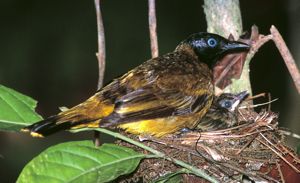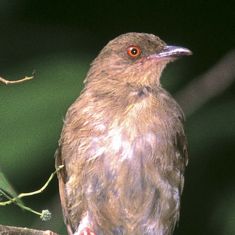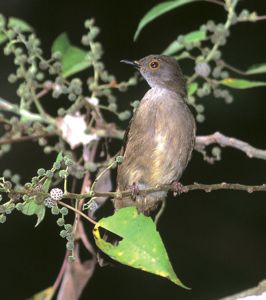Light enters the eye through the pupil. The iris (Latin for “rainbow), the coloured part of the eye surrounding the pupil, controls the amount entering the eye. When lighting is bright, the pupil closes. It opens up when lighting is reduced.
Although most birds have a dark, usually brown, iris around a black pupil, there are many with irises that are conspicuously coloured. The colours can be from white to yellow to orange, blue, red or even concentric rings of two or more colours, as in some grebes.
Iris colour can be important in bird identification in certain groups, like the bulbuls. There are 24 species of bulbuls in Peninsular Malaysia and Singapore. Many are similar in size and plumage colour, sometimes differentiated mainly by eye colour.
Indeed, many species have conspicuously coloured eyes, eyerings and eye wattles. The Asian and African species are known for their conspicuously coloured irises, from blue to red, orange, yellow or white, especially among the adult birds.
Take for example, the adult Cream-vented Bulbul (Pycnonotus simplex) (left top). It has cream-white eyes, especially in the Peninsular Malaysian race, although in Borneo there are those with red eyes. Immature, however, has dull-coloured eyes. On the other hand, the eyes of the Black-headed Bulbul (P. atriceps) are pale blue, that may appear whitish at a distance (left bottom).
Red-eyed Bulbul (P. brunneus), as the name implies, has red eyes, although sometimes it may be cream-coloured (bottom left).
Similarly the Straw-headed Bulbul (P. zeylanicus) has red eyes. In the Olive-winged Bulbul (P. plumosus), they are brownish-orange, red or dark red, and this is age related (top right). Those of the Finsch’s Bulbul (Alophoixus finschii) are pale yellow-brown to orange-brown. And in the Streaked Bulbul (Ixos malaccensis), they are dull reddish-brown to deep red. Spectacled Bulbul (P. erythropthalmos) has a red iris but there is also a yellow to yellow-orange eyering (right).
Input by Morten Strange and YC, images from the book “A Passion for Birds” courtesy of Ong Kiem Sian.
.
.
.
.
Reference:
Fishpool, L.D.C. & Tobias, J.A. (2005). Family Pycnonotidae (bulbuls). Pp. 124-251 in: del Hoyo, J., Elliott, A. & Christie, D. A. eds. Handbook of the birds of the world. Vol. 10. Cucuoo-shrikes to Thrushes. Barcelona: Lynx Editions.














